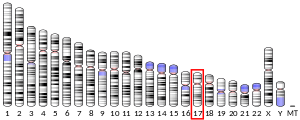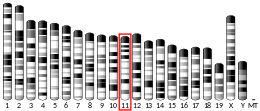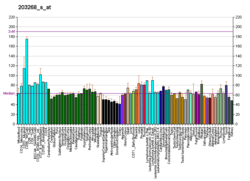DRG2
Developmentally-regulated GTP-binding protein 2 is a protein that in humans is encoded by the DRG2 gene.[5][6][7]
| DRG2 | |||||||||||||||||||||||||
|---|---|---|---|---|---|---|---|---|---|---|---|---|---|---|---|---|---|---|---|---|---|---|---|---|---|
| Identifiers | |||||||||||||||||||||||||
| Aliases | DRG2, developmentally regulated GTP binding protein 2 | ||||||||||||||||||||||||
| External IDs | OMIM: 602986 MGI: 1342307 HomoloGene: 1061 GeneCards: DRG2 | ||||||||||||||||||||||||
| |||||||||||||||||||||||||
| |||||||||||||||||||||||||
| |||||||||||||||||||||||||
| |||||||||||||||||||||||||
| Orthologs | |||||||||||||||||||||||||
| Species | Human | Mouse | |||||||||||||||||||||||
| Entrez | |||||||||||||||||||||||||
| Ensembl | |||||||||||||||||||||||||
| UniProt | |||||||||||||||||||||||||
| RefSeq (mRNA) | |||||||||||||||||||||||||
| RefSeq (protein) | |||||||||||||||||||||||||
| Location (UCSC) | Chr 17: 18.09 – 18.11 Mb | Chr 11: 60.45 – 60.47 Mb | |||||||||||||||||||||||
| PubMed search | [3] | [4] | |||||||||||||||||||||||
| Wikidata | |||||||||||||||||||||||||
| |||||||||||||||||||||||||
The DRG2 gene encodes the developmentally regulated GTP-binding protein 2, a name derived from the fact that it shares significant similarity to known GTP-binding proteins. DRG2 was identified because it is expressed in normal fibroblasts but not in SV40-transformed fibroblasts. Read-through transcripts containing this gene and a downstream gene have been identified, but they are not thought to encode a fusion protein. This gene is located within the Smith-Magenis syndrome region on chromosome 17.[7]
References
- GRCh38: Ensembl release 89: ENSG00000108591 - Ensembl, May 2017
- GRCm38: Ensembl release 89: ENSMUSG00000020537 - Ensembl, May 2017
- "Human PubMed Reference:". National Center for Biotechnology Information, U.S. National Library of Medicine.
- "Mouse PubMed Reference:". National Center for Biotechnology Information, U.S. National Library of Medicine.
- Schenker T, Trueb B (Jun 1998). "Assignment of the gene for a developmentally regulated GTP-binding protein (DRG2) to human chromosome bands 17p13→p12 by in situ hybridization". Cytogenet Cell Genet. 79 (3–4): 274–5. doi:10.1159/000134741. PMID 9605870.
- Schenker T, Lach C, Kessler B, Calderara S, Trueb B (Nov 1994). "A novel GTP-binding protein which is selectively repressed in SV40 transformed fibroblasts". J Biol Chem. 269 (41): 25447–53. PMID 7929244.
- "Entrez Gene: DRG2 developmentally regulated GTP binding protein 2".
Further reading
- Sprang SR (1998). "G proteins, effectors and GAPs: structure and mechanism". Curr. Opin. Struct. Biol. 7 (6): 849–56. doi:10.1016/S0959-440X(97)80157-1. PMID 9434906.
- Liang Y, Wang A, Belyantseva IA, et al. (2000). "Characterization of the human and mouse unconventional myosin XV genes responsible for hereditary deafness DFNB3 and shaker 2" (PDF). Genomics. 61 (3): 243–58. doi:10.1006/geno.1999.5976. PMID 10552926.
- Li B, Trueb B (2000). "DRG represents a family of two closely related GTP-binding proteins". Biochim. Biophys. Acta. 1491 (1–3): 196–204. doi:10.1016/s0167-4781(00)00025-7. PMID 10760581.
- Vlangos CN, Das P, Patel PI, Elsea SH (2000). "Assignment of developmentally regulated GTP-binding protein (DRG2) to human chromosome band 17p11.2 with somatic cell hybrids and localization to the Smith-Magenis syndrome critical interval". Cytogenet. Cell Genet. 88 (3–4): 283–5. doi:10.1159/000015539. PMID 10828610.
- Bi W, Yan J, Stankiewicz P, et al. (2002). "Genes in a Refined Smith-Magenis Syndrome Critical Deletion Interval on Chromosome 17p11.2 and the Syntenic Region of the Mouse". Genome Res. 12 (5): 713–28. doi:10.1101/gr.73702. PMC 186594. PMID 11997338.
- Strausberg RL, Feingold EA, Grouse LH, et al. (2003). "Generation and initial analysis of more than 15,000 full-length human and mouse cDNA sequences". Proc. Natl. Acad. Sci. U.S.A. 99 (26): 16899–903. doi:10.1073/pnas.242603899. PMC 139241. PMID 12477932.
- Song H, Kim SI, Ko MS, et al. (2005). "Overexpression of DRG2 increases G2/M phase cells and decreases sensitivity to nocodazole-induced apoptosis". J. Biochem. 135 (3): 331–5. doi:10.1093/jb/mvh040. PMID 15113831.
- Gerhard DS, Wagner L, Feingold EA, et al. (2004). "The Status, Quality, and Expansion of the NIH Full-Length cDNA Project: The Mammalian Gene Collection (MGC)". Genome Res. 14 (10B): 2121–7. doi:10.1101/gr.2596504. PMC 528928. PMID 15489334.
- Rual JF, Venkatesan K, Hao T, et al. (2005). "Towards a proteome-scale map of the human protein-protein interaction network". Nature. 437 (7062): 1173–8. doi:10.1038/nature04209. PMID 16189514.
This article is issued from Wikipedia. The text is licensed under Creative Commons - Attribution - Sharealike. Additional terms may apply for the media files.





